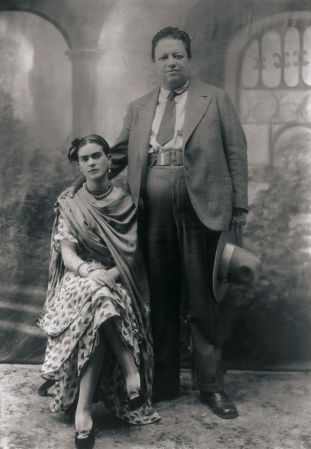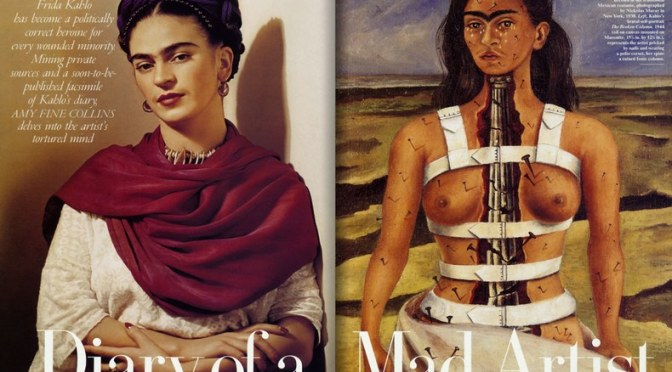This Feature Image depicts the beautiful and talented painter, Frida Kahlo (on left). It also shows one of Frida’s famous paintings called ‘The Broken Column’ that embodies her own severe pain and suffering (on right).
Feature Image sourced from:
https://www.vanityfair.com/culture/1995/09/frida-kahlo-diego-rivera-art-diary
INTRODUCTION – FRIDA KAHLO (1907 – 1954)
Dear Pain Matters blog readers,
I was first ‘introduced’ to the famous Mexican artist, Frida Kahlo, by my own beautiful daughter, Sarah, who invited me to watch the movie ‘Frida’ with her.
Diminutive in stature, Frida was larger than life itself.
Known for her talent as a Surrealist painter, Frida is a beloved cultural icon in Mexico.
Sadly, Frida endured a spate of tragedies that resulted in lifelong chronic pain including excruciating back pain.
Born to a German father and a mestiza* mother on 6 July 1907, Frida was stricken with polio when she was about 6. Polio caused her right leg and foot to be severely damaged and left her with a permanent limp.
Sadly, polio was not the only tragedy in Frida’s life.
Quoting Frida:
‘I suffered two grave accidents in my life. One involved a bus, the other is [husband] Diego.’
FRIDA’S FIRST GRAVE ACCIDENT – THE BUS CRASH
In addition to polio, tragedy struck on 17 September 1925 when Frida was only 18. While returning home from Mexico City with her then-boyfriend, the wooden bus that they were travelling in crashed into a tram.
During this bus accident that involved multiple fatalities, a steel handrail smashed Frida’s pelvis and was impaled through her left hip, belly and womb, exiting through her genitals.
Needless to say, Frida’s injuries were severe and horrific and included fractures in her back, collarbone and two ribs. Her lower spine and pelvis were both broken in 3 different places while her left shoulder was out of joint. Frida’s polio-deformed right leg had eleven (11!) fractures and her right foot was dislocated and crushed (Rogers, 2009). (Wow! Imagine going through all that!!)
Amazed that Frida barely survived this terrible bus accident, doctors (correctly) predicted that she would never have children.
Instead, chronic pain would become her ultimate companion.
To distract herself from the boredom of 2 years of bed rest including months in a plaster corset to hold her body in place, Frida started to paint extensively and with great passion.
It was at this stage in her life when Frida decided to become a painter instead of a doctor.
FRIDA’S SECOND ‘GRAVE ACCIDENT’ – HER VOLATILE MARRIAGE WITH FAMOUS ARTIST, DIEGO RIVERA
On 21 August 1929, Frida married Diego Rivera, a chronic cheater during his previous relationships. At 42, Diego was 20 years older than Frida, overweight and very big. Diego was also a well-travelled and famous painter whose friends included Pablo Picasso, Amedeo Modigliani and Leon Trotsky.

Wedding photo of Frida and Diego
Source of Image:
Pinterest and https://www.watson.ch/wissen/frauen%20der%20geschichte/407183389-frida-kahlo-die-frau-die-den-tod-auslachte
Whilst in love, their relationship was a turbulent one that included a year-long divorce. Diego continued with his many extramarital affairs.
Deciding to ‘fight fire with fire’, Frida indulged in her own extramarital affairs (including an affair with her husband’s friend, Leon Trotsky) while also exploring intimacy and sexuality with other women.
While trying to have a baby with Diego, Frida had to abort a pregnancy because of health issues pertaining to her bus crash in 1925. She also suffered a miscarriage in 1932 (Espinoza, 2007).
(Whilst it would be interesting to explore Frida’s vivacious and colourful love life, this is outside the scope of this blog. See references below including Lisa Waller Rogers for further details.)
FRIDA’S CHRONIC PAIN INCLUDING SEVERE BACK PAIN
Frida endured more than 30 operations after her severe bus accident until her death in 1954. This included 7 spinal operations, one that involved a 2nd spinal fusion because the wrong vertebrae were fused during an earlier operation. Frida also had her right leg amputated (see below).
Frida’s increasing pain levels meant that she could only paint for short periods of time.
Frida’s health issues only worsened with time. Her rigid medical corset no longer supported her failing spine and she had to undergo radical spinal and leg surgery.
In 1953, her right leg had to be amputated below her knee due to gangrene that may have resulted from a previous surgery.
Sadly, Frida, the Mexican Heroine of Pain (La Heroina del Dolor), died on 13 July 1954, having turned 47 only one week earlier.
TWO PAINTINGS BY FRIDA – ‘THE BROKEN COLUMN’ AND ‘TREE OF HOPE’
‘The Broken Column’ (1944)
When looking at her painting, ‘The Broken Column’ (shown earlier and below), people often assumed that Frida was a Surrealist painter. In actual fact, Frida expressed her own reality that included severe pain in the ‘The Broken Column’.
In her words,
‘They thought I was a Surrealist, but I wasn’t. I never painted dreams. I painted my own reality.’
‘My painting carries with it the message of pain.’
Thus, Frida used her painting, The Broken Column’, to express her own excruciating pain and suffering.

‘The Broken Column’ (Frida Kahlo, 1944)
Source of Image:
http://www.people.vcu.edu/~djbromle/artviewsnet/2002/students2002/kahlo/PetersKahlo.htm
As seen here, repeated spinal surgery had confined her body in a rigid corset apparatus. Despite holding her broken body together, her corset appears very tight, uncomfortable and restrictive.
Frida’s spinal column appears to be cracked, broken and injured in many places.
The nails embedded throughout her body clearly show the severity of her pain and suffering.
Frida shows herself as being alone in a barren wasteland. This further adds to a sense of hopelessness, helplessness, emptiness and despair.
Despite all her pain, suffering, sadness and vulnerability, Frida exudes beauty, elegance, femininity and dignity in ‘The Broken Column’ (Peters, 2002).
‘Tree of Hope’ (1946)

‘Tree of Hope’ (Frida Kahlo, 1946)
Source of Image:
https://www.fridakahlo.org/tree-of-hope.jsp
Despite bed rest and wearing a steel corset for 8 months following yet another spinal surgery, Frida’s health issues including sharp pains in her back became worse.
In response to her severe back pain and deteriorating health, Frida painted the ‘Tree of Life’.
Although Frida is seen weeping in this painting, she is hopeful for a recovery from her recent spinal operation. The Spanish words ‘Cielito Lindo’ (‘Tree of Hope, keep strong’) appear on a flag in her right hand. This flag has a red tip that looks like a surgical instrument stained with blood. Frida holds a pink orthopaedic corset in her left hand.
Frida is also seen under anaesthetic in hospital and bleeding from fresh surgical wounds following her spinal operation.
In the background, the landscape looks forlorn and barren without a trace of hope. There are 2 large fissures in the dry earth that mirror the 2 gaping wounds in Frida’s back.
Quoting Frida, this painting was ‘nothing but the result of the damned operation!’
SUMMARY
Frida leaves behind a legacy of her paintings despite suffering, and perhaps because she suffered, from chronic pain during most of her life.
I hope that you find Frida’s story inspirational, in particular, her passion for art, life and love despite enduring severe and debilitating chronic pain.
Sabina Walker
Blogger, Pain Matters (in WordPress)
* A mestiza is a person with indigenous and European ancestry.
REFERENCES
Peer-Reviewed Articles
(1) Courtney, Carol A et al; Frida Kahlo: Portrait of Chronic Pain. Physical Therapy (1 January 2017); 97(1): 90–96.
doi: 10.2522/ptj.20160036
https://academic.oup.com/ptj/article/97/1/90/2896952
https://www.ncbi.nlm.nih.gov/pubmed/27562644
(2) Antelo, Fernando. Images of Healing and Learning- Pain and the Paintbrush: The Life and Art of Frida Kahlo. American Medical Association Journal of Ethics – Virtual Mentor(May 2013); 15(5): 460-465.
doi 10.1001/virtualmentor.2013.15.5.imhl1-1305
https://www.ncbi.nlm.nih.gov/pubmed/23680570
https://journalofethics.ama-assn.org/sites/journalofethics.ama-assn.org/files/2018-06/imhl1-1305.pdf
https://journalofethics.ama-assn.org/article/pain-and-paintbrush-life-and-art-frida-kahlo/2013-05
Media, Blogs and Newspaper Articles
(1) Courtney, Carol A. Frida Kahlo’s life of chronic pain.
https://blog.oup.com/2017/01/frida-kahlos-life-of-chronic-pain/
(2) Espinoza, Javier. Frida Kahlo’s last secret finally revealed. The Guardian – Australia Edition (12 August 2007).
https://www.theguardian.com/world/2007/aug/12/artnews.art
(3) Walter, Natasha. Feel my pain. The Guardian – Australia Edition (21 May 2005).
(5A) Frida Kahlo and Diego Rivera – Love and Pain. Art Gallery of NSW (25 Jun – 23 Oct 2016).
https://www.artgallery.nsw.gov.au/artboards/frida-kahlo-diego-rivera/love-and-pain/
(5B) Verghis, Sharon. Frida Kahlo: artistic genius and queen of pain. The Weekend Australian (18 June 2016).
(6) Mantalvanos, Soula. Frida Kahlo: Portrait of Chronic Pain. Pudental Nerve – Soula’s Chronic Pelvic Pain Story (25 August 2016).
https://pudendalnerve.com.au/2018/06/09/frida-kahlo-portrait-of-chronic-pain/
(7) neurophilosophy. Frida Kahlo’s life of pain. Science Blogs(24 January 2008).
https://scienceblogs.com/neurophilosophy/2008/01/24/frida-kahlos-life-of-pain
(8) Siqueira-Batista, Rodrigo et al.Art and pain in Frida Kahlo. Rev. dor – São Paulo (April/June 2014); 15(2).
http://dx.doi.org/10.5935/1806-0013.20140018
http://www.scielo.br/scielo.php?script=sci_arttext&pid=S1806-00132014000200139
(9) Peters, Katie. Frida Kahlo’s Self-Portraits – The Broken Column (1944). Virginia Commonwealth University(2002).
http://www.people.vcu.edu/~djbromle/artviewsnet/2002/students2002/kahlo/PetersKahlo.htm
(10) Kelley, Wes. The Painful Life of Frida Kahlo: How Injury Led to Inspiration.
Medium(14 Oct 2016).
(11) Medrut, Flavia. 17 Frida Kahlo Quotes to Inspire You to Turn Pain Into Beauty. Goalcast (28 November 2017).
https://www.goalcast.com/2017/11/28/17-frida-kahlo-quotes/
(12) Exploring Frida Kahlo’s Relationship With Her Body
https://artsandculture.google.com/theme/EQICSfueb1ivJQ
(13) Brown, Amy. Frida Kahlo – An Amazing Woman (1907-1954)
(14) Collins, Amy Fine. Diary Of A Mad Artist. Vanity Fair (3 Sept 2013).
https://www.vanityfair.com/culture/1995/09/frida-kahlo-diego-rivera-art-diary
(15) Frida Kahlo
https://en.wikipedia.org/wiki/Frida_Kahlo
(16) Frida Kahlo Corporation
https://fridakahlocorporation.com
(17) Frida Kahlo – Paintings, Biography, Quotes
https://www.fridakahlo.org/tree-of-hope.jsp
(18) Katz, Neil. Frida Kahlo Biography: Medical Mystery, Controversial Death. CBS News (6 July 2010).
https://www.cbsnews.com/news/frida-kahlo-biography-medical-mystery-controversial-death/
(19) Rogers, Lisa Waller. Lisa’s History Room – Where the Past is Always Present (26/27 May 2009).
Frida’s First Bad Accident.
https://lisawallerrogers.com/2009/05/26/frida-kahlos-first-bad-accident/
Frida Kahlo’s Other Accident.
https://lisawallerrogers.com/2009/05/27/frida-kahlos-other-accident/
Frida Kahlo: A Few Small Nips.
https://lisawallerrogers.com/2009/05/27/frida-kahlo-a-few-small-nips/
Many other fascinating blog posts by Lisa Waller Rogers are offered here:
https://lisawallerrogers.com/?s=frida+kahlo
https://lisawallerrogers.com/page/2/?s=frida+kahlo
https://lisawallerrogers.com/2009/06/10/fridas-red-hot-lover/
Films
(1A) Frida. A Hollywood production by Miramax directed by Julie Taymor (2002; 123 minutes).
https://www.miramax.com/movie/frida/
(1B) Frida, Naturaleza Viva. A Mexican film directed by Paul Leduc (1983).
Cartoons
(1) La heroine del dolor (heroine of pain).
https://zenpencils.com/comic/fridakahlo/
Article in German
(1) Rothenfluh, Anna. Frida Kahlo: Die Frau, die den Tod auslachte. Watson (14 Jan 2018).
